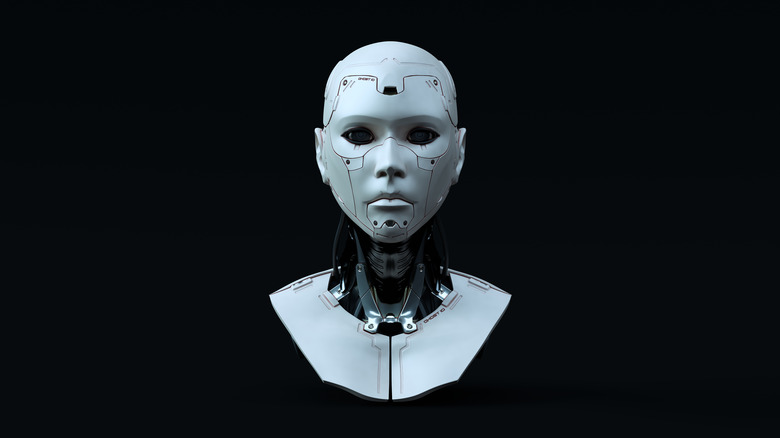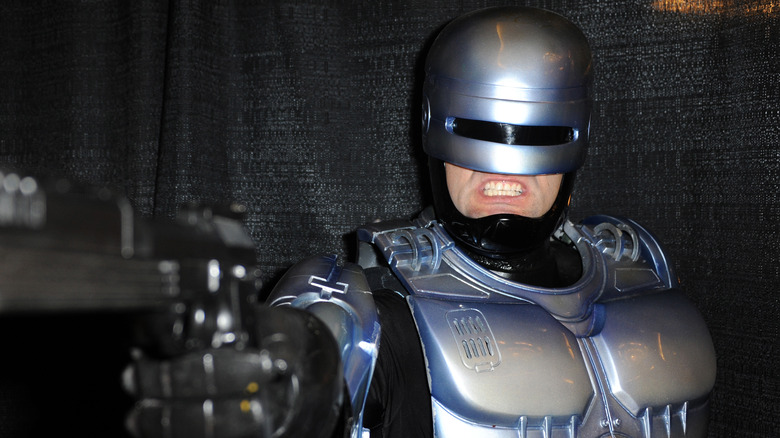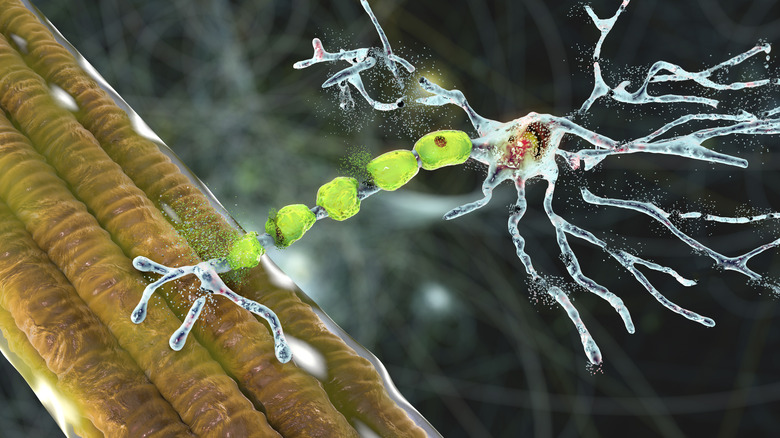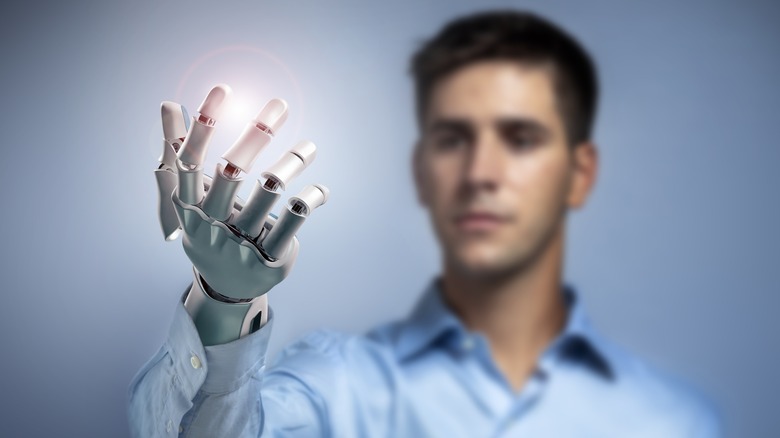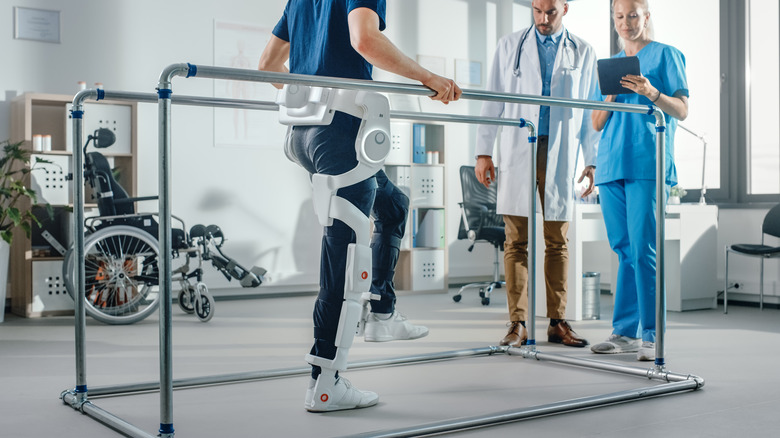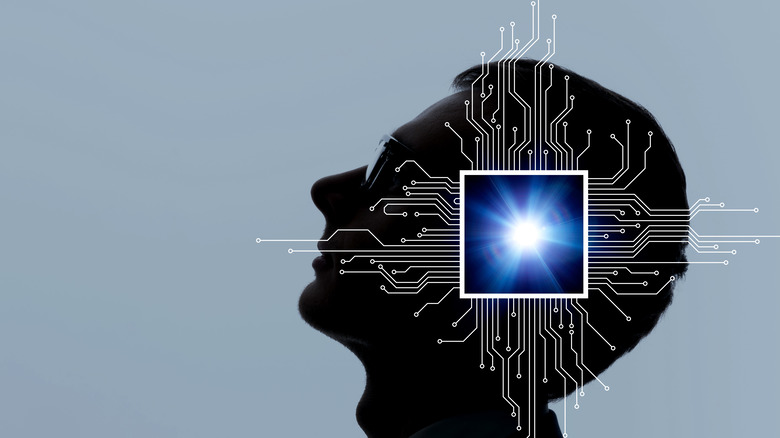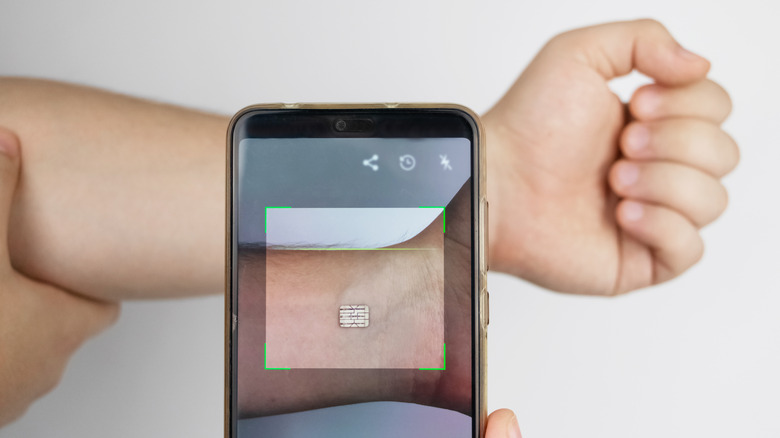What You Need To Know About The World's First Human Cyborg
Earlier this year Dr. Peter Scott-Morgan died after battling with motor neuron disease for many years. He was diagnosed with the condition in 2017 and given around two years to live. However, the scientist underwent a series of operations to extend his lifespan and looked towards technology as a way to counteract the debilitating effects of the disease. Scott-Morgan survived three years longer than doctors had initially expected and passed away at the age of 64 in June 2022 (via the NZ Herald).
Speaking during his time as the head of The MND association, Scott-Morgan alluded to the difference technology could make to people in his position. He said: "We're now well into the 21st Century. This is the age of hi-tech and there are huge benefits in us exploring just how people living with MND can benefit from all the billions being spent by the gaming industry on virtual reality, the automotive industry on driverless cars, the computing industry on expressive voice synthesizers and so on. It's all potentially life-changing for those of us with MND." The scientist was so immensely passionate about the idea of overcoming his illness with tech that he personally used it extensively in an attempt to bypass his condition. This led to the professor of robotics being referred to as "The World's First Human Cyborg." That title also formed the basis for a 2020 documentary Scott-Morgan featured in for the United Kingdom's Channel 4.
Cyborgs are part man, part machine
According to Vocabulary.com, a cyborg is "An organism that is partly mechanical and partly biological." The character the website uses as a popular culture example is Darth Vader. After being set on fire, Vader had several body parts replaced with robotic alternatives and had a life support system installed in his suit. While lightsabers aren't going to happen, and you're not going to lift objects up with your mind any time soon, we may see Vader-like cyborgs on Earth.
In a way, Peter Scott-Morgan was similar, though there is no evidence of him falling to the dark side and killing off a temple full of children. Morgan used today's technology to prolong his life and help work around the disabilities his condition caused. He even had an artificial voice. The concept of a cyborg didn't begin with Scott-Morgan or Vader, they've been a large part of the science fiction genre for a long time.
Cyborgs are huge in science fiction
Watch pretty much any sci-fi series and cyborgs will probably crop up at some point. The blending of man and machines seemed inevitable in the minds of sci-fi writers, and now it seems inevitable in reality. Fictional cyborgs, which have appeared in everything from "Back to the Future 2" to "Robocop," often have superhuman abilities. The real-life versions may not be that far out there.
For the most part, blending machines with humans will be a cutting-edge way to improve life for people with disabilities — at least at first. People like Elon Musk have suggested that brain implants could greatly increase a person's cognitive abilities, enabling them to compete with advanced artificial intelligence. For the most part, cybernetic enhancements that aren't being made for medical reasons only seem to offer marginal quality-of-life improvements. You can pay for something by tapping your hand on a scanner, and you may be able to control a TV with your mind in a few years. This may create somewhat of an uptake problem amongst the majority of the population, as none of that seems like it's worth going through brain surgery for. The modern world is starting to resemble a dystopia in several ways, but we're probably not ready to go full "Cyberpunk 2077" just yet.
Scott-Morgan suffered from motor neuron disease
There are several kinds of motor neuron disease, but the most well-known is Amyotrophic Lateral Sclerosis (ALS) which has affected a number of public figures and was the subject of a viral charity challenge a few years back. Dr. Scott-Morgan suffered from the condition, as did astrophysicist Professor Stephen Hawking, and baseball hall of famer Lou Gehrig.
As its name suggests, the disease affects nerve cells known as motor neurons which are present in a person's brain and spinal cord. MND causes these cells to die, and messages are then unable to be sent from the brain to other parts of the body. ALS affects neurons in both the brain and spinal cord, which means sufferers eventually lose control of their muscles. The unused muscles then atrophy. ALS sufferers eventually become paralyzed, and as some of the affected muscles are required for things like eating and breathing, the condition is fatal. According to Web MD, anyone can get the disease, it is most commonly diagnosed in people aged between 40 and 50, and sufferers tend to survive between three and five years, though some have lasted over a decade. There is currently no cure for ALS or any other motor neuron disease, though if Scott-Morgan was correct, advances in medicine and technology could change that.
Scott-Morgan was arguably the first human cyborg
Throughout his life, Dr. Peter Scott-Morgan was somewhat of a pioneer. Back in the 80s, he became the first man in the U.K. to receive a Ph.D. in Robotics (via The Guardian). That Ph.D. would come in handy years later when he was exploring ways to stave off ALS. In another first, he opted to use himself as a "human guinea pig" in an attempt to trial procedures and equipment that would help create "Peter 2.0."
One of the earliest, and most extreme, procedures Scott-Morgan underwent involved huge changes to how his digestive system functioned. A feeding tube was inserted, which would allow "Peter 2.0" to take in nutrition long after "Peter 1.0" had lost the ability to chew and swallow. At the other end, a catheter and colostomy bag took care of any waste. This was just one of several procedures Scott-Morgan opted for in an attempt to stay one step ahead of his illness. Others would continue to take away parts of Peter 1.0, like his ability to speak naturally, in order to give Peter 2.0 more time. The process went beyond surgery, with robotic enhancements like a digital avatar, an electric voice box, and a wheelchair that doubled as an exoskeleton. Although these things helped counteract some of the worst effects of MND, Scott-Morgan also believed similar technology could benefit a wide section of humanity.
He saw robotic enhancements as a kind of evolution
Evolution is how humanity got to where it is, but it wasn't a quick process. Billions of years passed between the emergence of the single-celled organisms that were the planet's first known lifeforms, and everything we see around us now (via the Natural History Museum). There is also an argument that we are stunting our evolution with technological advancements. Evolution tends to be caused by struggles or "pressures" killing off less well-adapted members of a species. People are intelligent enough to counteract all but the most extreme pressures. We inhabit all parts of the planet and have set foot on the moon. We've developed drugs to counteract diseases. There are also objects like glasses to help alleviate conditions like eyesight issues — something that would be a major problem for a wild animal.
Scott-Morgan saw things differently. He believed technological advancements could be used to enhance us as a species. According to the New York Post, the "cyborg" said: "At the moment, we are unable to evolve. Meanwhile, AI and robotics are accelerating ahead. I want us to jump aboard while we still can. We are at the early dawn of escaping the fear of becoming infirm, of being powerless, of feeling trapped in an inadequate body. Everyone on the planet, even in the poorest communities, will work closely with AI, but some of us will go far further and actually merge with AI to extend what being human means." Scott-Morgan also believed the advancements he envisioned were closer to reality than most people might think. He pictured "neo-humans" only being a few decades away, rather than something in the far distant future.
Technology helped him talk again, and he hoped it would help him walk too
One of the procedures Scott-Morgan had to have in order to extend his life involved the removal of his larynx. With the larynx out of the way, an apparatus could be installed that would take control of the professor's breathing. Had he not undergone the operation, there was a danger he could develop pneumonia due to saliva entering his lungs. The professor would eventually lose control of his lungs anyway, as his condition worsened. Unfortunately, without a larynx, you can't talk, but Scott-Morgan found a way around that. The surgery would theoretically extend his life, and the technology available would alleviate the worst side effects (via The New Yorker).
Before the op, Scott-Morgan recorded over 20,000 words in his own voice. Coupled with a program that let him type using his eyes, this allowed the MNS sufferer to communicate in a voice that was familiar to him. Motion capture was also used to make record his facial expressions. These were eventually used with an animated avatar Scott-Morgan could display on a screen. There were plans to project the expressions directly onto his face once his muscles were fully paralyzed, but that never materialized. Exoskeletons may also bring mobility back to ALS sufferers' limbs one day. Scott Morgan also possessed a wheelchair that doubled as an exoskeleton, allowing him to stand up and lie down at will (via the Medical Device Network). While his "exoskeleton" didn't allow him to walk, the technology is there to some degree and will only improve as time goes on.
People have been augmenting their bodies for a while
Although Scott-Morgan is referred to as the "First Human Cyborg," people have been augmenting their bodies with technology for years. At the least extreme end, there's wearable technology like augmented reality glasses which provide additional insight into the world around you. A more common example is the smartwatch, which provides information and also monitors things like your heart rate.
Wearable technology can easily be removed, but people have been going to greater extremes for a while. NFC chips are commonly inserted into pets to help get them back to their owners when they get lost — but some have been jabbed into humans too. The chips store small amounts of information that can be accessed via a scanner, and this opens up a range of possibilities. You could have a key to your home, a credit card, or even your bitcoin wallet in the palm of your hand 24/7. RFID chips can also be implanted for similar purposes. They could also have a use beyond just paying for things. Passports and security clearances could be stored on the chips, as could important medical information.
Similar advancements could be huge for disabled people
Advances in "cyborg" technology could vastly improve the quality of life of a vast range of disabled people. Disabilities can be caused by a wide range of issues, but some may be cured or mitigated by bypassing a damaged or underdeveloped body part. Almost a decade ago, scientists gave hope to the blind when they developed a retinal implant that could use the eye itself to produce a higher-definition image than was previously possible.
As in Scott-Morgan's case, an exo-skeleton could give people who have been paralyzed through injury or disease the power to walk again. If Neuralink, or similar projects, ever make it through the testing phase then a single brain implant might be enough to cure a large number of ailments. People might even be able to upload their memories, which could help individuals suffering from conditions like Alzheimer's, or even provide a kind of backup that could be used should a person suffer a brain injury or stroke.
Cyborgs could get a lot more advanced in the coming years
While some of the advancements Scott-Morgan had access to may seem cutting-edge, things are still improving. One of the areas where we could see advancement is in interfacing. Towards the end of his life, the "human cyborg" had to use eye movements to type out what he wanted to say. Things may get easier if Elon Musk's brain chip company Neuralink fulfills its goals.
Neuralink, and similar products in development, involve implanting a chip directly into a user's brain. The chip then reads electrical signals the person's brain produces as they think and translates those signals into actions. Musk believes this chip could be used to help paralyzed people interface with smartphones and computers faster than an able-bodied user currently can. Musk also believes the chips could be used to help quadriplegics regain the use of their limbs. Neuralink is still in the animal testing phase, and some reports indicate things aren't going too well. There have been indications that most of the monkeys the implant has been tested on did not survive for very long. Musk believes we could see human trials of Neuralink in 2023, but as things stand the FDA has yet to give clearance.
People could also become cyborgs for more trivial reasons
Neuralink could be a miracle for people with debilitating conditions, but people may take the risks that come with getting wires probed into your brain for more trivial reasons. In the long term, Musk claims Neuralink will be something people can have installed in a doctor's office in just a couple of hours. It could then theoretically be used to interact with things like phones, tablets, laptops, and televisions. More outlandish claims include things like being able to stream music directly into your brain.
There are also other reasons something like Neuralink may appeal to able bodied people. Musk has touted it as a way regular humans could compete with advanced AI. The chip could be used to improve people's cognitive ability, allowing them to think faster and solve problems in shorter time frames. In a few years' time Neuralink could be several things. It may be a massive help to people with medical conditions, it might not exist at all, or it could be something everyone will have jammed into their skulls. Either way, other technologies will certainly advance, and Dr. Peter Scott-Morgan's prediction of a "neo-human" future may not be too far out.
